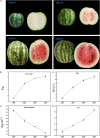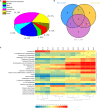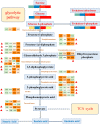Metabolome and Transcriptome Integration Reveals Insights Into Flavor Formation of 'Crimson' Watermelon Flesh During Fruit Development
- PMID: 34054886
- PMCID: PMC8153042
- DOI: 10.3389/fpls.2021.629361
Metabolome and Transcriptome Integration Reveals Insights Into Flavor Formation of 'Crimson' Watermelon Flesh During Fruit Development
Abstract
Metabolites have been reported as the main factor that influences the fruit flavor of watermelon. But the comprehensive study on the dynamics of metabolites during the development of watermelon fruit is not up-to-date. In this study, metabolome and transcriptome datasets of 'Crimson' watermelon fruit at four key developmental stages were generated. A total of 517 metabolites were detected by ultrahigh-performance liquid chromatography-electrospray ionization-tandem mass spectrometry and gas chromatography-solid-phase microextraction-mass spectrometry. Meanwhile, by K-means clustering analysis, the total differentially expressed genes were clustered in six classes. Integrating transcriptome and metabolome data revealed similar expression trends of sugars and genes involved in the glycolytic pathway, providing molecular insights into the formation of taste during fruit development. Furthermore, through coexpression analysis, we identified five differentially expressed ADH (alcohol dehydrogenase) genes (Cla97C01G013600, Cla97C05G089700, Cla97C01G001290, Cla97C05G095170, and Cla97C06G118330), which were found to be closely related to C9 alcohols/aldehydes, providing information for the formation of fruit aroma. Our findings establish a metabolic profile during watermelon fruit development and provide insights into flavor formation.
Keywords: coexpression; metabolome; sugars; transcriptome; volatile organic compounds; watermelon.
Copyright © 2021 Gong, Diao, Zhu, Umer, Zhao, He, Lu, Yuan, Anees, Yang, Kaseb and Liu.
Conflict of interest statement
The authors declare that the research was conducted in the absence of any commercial or financial relationships that could be construed as a potential conflict of interest.
Figures





Similar articles
-
An integrated transcriptome and metabolome approach reveals the accumulation of taste-related metabolites and gene regulatory networks during watermelon fruit development.Planta. 2021 Jul 22;254(2):35. doi: 10.1007/s00425-021-03680-7. Planta. 2021. PMID: 34292405
-
Multi-omics integration to explore the molecular insight into the volatile organic compounds in watermelon.Food Res Int. 2023 Apr;166:112603. doi: 10.1016/j.foodres.2023.112603. Epub 2023 Feb 17. Food Res Int. 2023. PMID: 36914327
-
Transcriptome regulation of carotenoids in five flesh-colored watermelons (Citrullus lanatus).BMC Plant Biol. 2021 Apr 28;21(1):203. doi: 10.1186/s12870-021-02965-z. BMC Plant Biol. 2021. PMID: 33910512 Free PMC article.
-
Integrated Metabolome and Transcriptome Analysis Provide Insights into the Effects of Grafting on Fruit Flavor of Cucumber with Different Rootstocks.Int J Mol Sci. 2019 Jul 23;20(14):3592. doi: 10.3390/ijms20143592. Int J Mol Sci. 2019. PMID: 31340498 Free PMC article.
-
The flavor of pomegranate fruit: a review.J Sci Food Agric. 2014 Jan 15;94(1):21-7. doi: 10.1002/jsfa.6311. Epub 2013 Aug 19. J Sci Food Agric. 2014. PMID: 23881410 Review.
Cited by
-
Genome-wide association study provides genetic insights into natural variation in watermelon rind thickness and single fruit weight.Front Plant Sci. 2022 Dec 6;13:1074145. doi: 10.3389/fpls.2022.1074145. eCollection 2022. Front Plant Sci. 2022. PMID: 36561452 Free PMC article.
-
Transcriptomic and Metabolomic Analyses Provide Insights into the Formation of the Peach-like Aroma of Fragaria nilgerrensis Schlecht. Fruits.Genes (Basel). 2022 Jul 20;13(7):1285. doi: 10.3390/genes13071285. Genes (Basel). 2022. PMID: 35886068 Free PMC article.
-
Detection and comparative analysis of VOCs between tomato and pepper based on GC×GC-TOFMS.Sci Rep. 2025 Feb 20;15(1):6140. doi: 10.1038/s41598-025-90796-5. Sci Rep. 2025. PMID: 39979509 Free PMC article.
-
Combined Metabolome and Transcriptome Analysis Elucidates Sugar Accumulation in Wucai (Brassica campestris L.).Int J Mol Sci. 2023 Mar 2;24(5):4816. doi: 10.3390/ijms24054816. Int J Mol Sci. 2023. PMID: 36902245 Free PMC article.
-
Metabolomic and transcriptomic analyses reveal the effects of grafting on blood orange quality.Front Plant Sci. 2023 Jun 1;14:1169220. doi: 10.3389/fpls.2023.1169220. eCollection 2023. Front Plant Sci. 2023. PMID: 37360739 Free PMC article.
References
-
- Barrett D. M., Beaulieu J. C., Shewfelt R. (2010). Color, flavor, texture, and nutritional quality of fresh-cut fruits and vegetables: desirable levels, instrumental and sensory measurement, and the effects of processing. Crit. Rev. Food Sci. Nutr. 50 369–389. 10.1080/10408391003626322 - DOI - PubMed
LinkOut - more resources
Full Text Sources
Other Literature Sources
Research Materials
Miscellaneous

